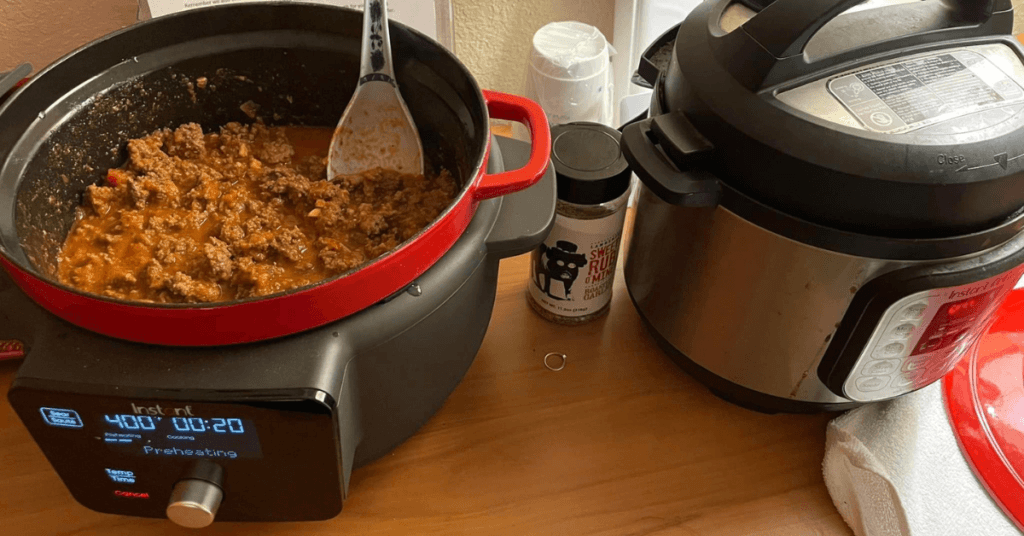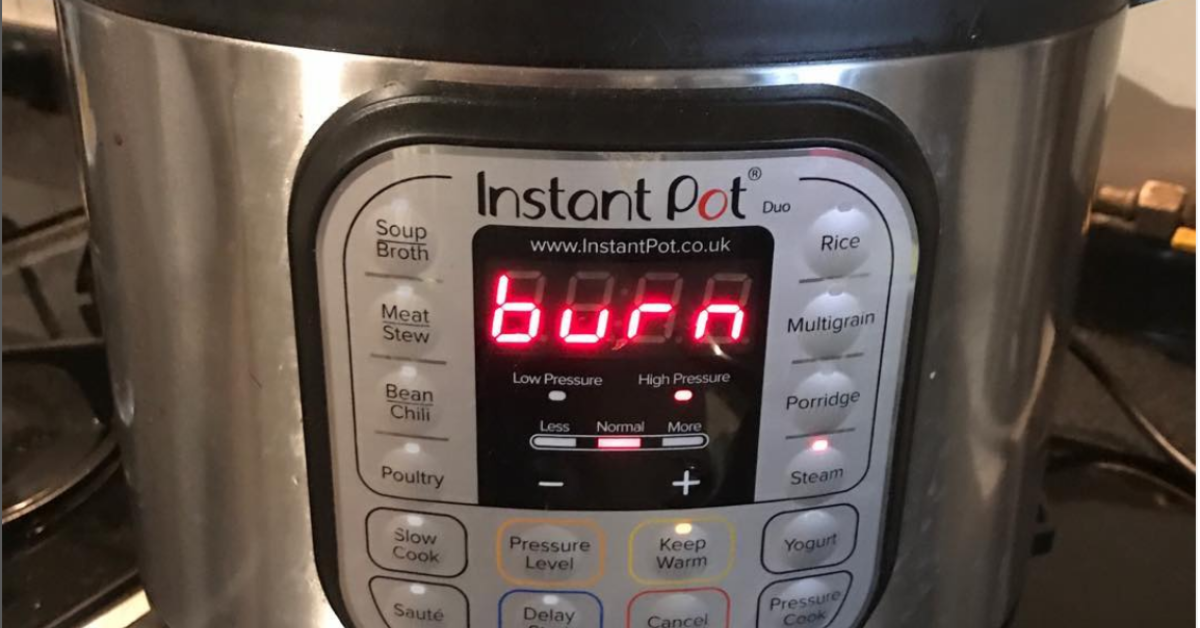Hey there!
Do you enjoy using the Instant Pot?
If so, you are not by yourself.
For good reason, this useful kitchen tool has become a favorite among home cooks worldwide.
The Instant Pot can simplify mealtime because it can pressure cook, sauté, slow cook, and do so much more.
However, have you ever been using your Instant Pot when you weren’t quite sure when it was done cooking?
You may be concerned that even though you thought you had turned off the stovetop, it is still cooking on the “Burn” setting.
Don’t worry, though! We have your back.
In this article, we’ll examine the operation of the Instant Pot in more detail and discuss precautions you can take to ensure its secure and efficient operation.
So, whether you’re an experienced user or a novice, keep reading to find out how to avoid the “Burn” setting and maximize your Instant Pot.
Will Instant Pot Keep Cooking on Burn? (Quick Answer)
Even after you have turned the Instant Pot off, it may still cook food on the “Burn” setting. This can occur for a number of reasons, including the kind and quantity of food, the Instant Pot’s size, and the recipe being used. To avoid burn cooking, it’s critical to be aware of these elements and use the Instant Pot safely. It’s also important to keep in mind that the “Burn” setting is only meant to be used for browning and sautéing food before pressure cooking. As a result, it should only be used for a brief time and food shouldn’t be cooked on “Burn” for an extended period of time.
How the Instant Pot Works

The Instant Pot is an electric pressure cooker that allows you to cook food quickly and easily.
It functions by enclosing the area and trapping steam inside, which raises the pressure and water’s boiling point.
Thus, compared to cooking on a stovetop, the food cooks more quickly and at a higher temperature.
The Instant Pot has several different components that work together to create this pressure-cooking environment.
The base of the Instant Pot is where the heating element is located, and this is where the food is cooked.
Above the base is the cooking pot, which is made of stainless steel and is where the food is placed. The cooking pot is surrounded by a safety lid, which creates a sealed environment.
There is also a pressure release valve and a pressure indicator, which are used to monitor the pressure inside the Instant Pot.
The “Burn” setting on the Instant Pot is used when you want to brown or sauté food before pressure cooking it.
When you select the Burn setting, the heating element in the base of the Instant Pot heats up, allowing you to sauté ingredients in the cooking pot.
Once you’ve browned your food, you can then switch to the pressure cooking setting to finish cooking the meal.
It’s important to note that, the “Burn” setting is used for sautéing and browning before pressure cooking, not for pressure cooking itself.
Therefore, it should be used for a short period of time, and it’s not recommended to leave food cooking on “Burn” for extended periods of time.
If food is left cooking on the Burn setting for too long, it can overheat, leading to the potential burn cooking as described in the first section.
Factors that Affect Burn Cooking
There are several factors that can contribute to the Instant Pot continuing to cook on the Burn setting, even after you think you’ve turned it off.
Some of these factors include the type and amount of food you’re cooking, the size of the Instant Pot, and the recipe you’re using.
The Type Of Food
First, the type of food you’re cooking can affect whether or not the Instant Pot continues to cook on the Burn setting.
For example, starchy foods like potatoes and pasta tend to stick to the bottom of the cooking pot and can cause the Instant Pot to continue cooking on Burn, even after you’ve turned it off.
Similarly, if you’re cooking a large amount of food, the food may not be able to circulate properly inside the Instant Pot, which can also cause the Burn setting to stay on.
The Size of The Instant Pot
Cooking that burns can also be affected by the Instant Pot’s size. The food may be too close to the heating element if you’re using a smaller Instant Pot, which could cause it to cook too quickly and possibly result in burn cooking.
Similarly to this, if you’re using a larger Instant Pot, the food might be too far from the heating element, which could result in overcooking.
The Recipe

Finally, the recipe you’re using can also affect burn cooking.
Some recipes may call for a longer cooking time on the Burn setting than others, which can cause the Instant Pot to continue cooking on Burn even after you’ve turned it off.
Additionally, some recipes may not be suitable for the Instant Pot at all and can lead to burn cooking.
For example, if you’re cooking a dish that requires a lot of stirring, like risotto, you may find that the Instant Pot continues to cook on the Burn setting even after you’ve turned it off.
This is because the starch in the rice can stick to the bottom of the cooking pot and cause the Instant Pot to overheat.
Another illustration is the possibility that the Instant Pot will continue to cook on the Burn setting even after you have turned it off if you are cooking something that doesn’t require pressure cooking, such as a simple soup.
This is due to the possibility that the soup is too thin and cannot properly circulate inside the Instant Pot, which can lead to overheating.
When using the Instant Pot to prepare meals, it’s crucial to keep these things in mind in order to avoid burn cooking and guarantee that your food is always delicious.
Safety Considerations

It’s important to be aware of the potential hazards of the Instant Pot continuing to cook on the Burn setting.
One of the main hazards is the risk of overcooking, which can cause your food to become dry, tough, and unappetizing.
Additionally, if the Instant Pot continues to cook on the Burn setting for too long, it can cause burn injuries if you’re not careful.
Another potential hazard is the risk of damage to the Instant Pot.
If the Instant Pot continues to cook on the Burn setting for too long, it can cause the cooking pot or the safety lid to become damaged, which can be costly to replace.
To prevent burn cooking, it’s important to understand how the Instant Pot works and to be aware of the various factors that can contribute to burn cooking.
Here are some tips and guidelines for safely using the Instant Pot and preventing burn cooking:
- Always read the recipe carefully before you begin cooking and make sure that it’s suitable for the Instant Pot.
- Use the appropriate size Instant Pot for the amount of food you’re cooking.
- Avoid overcrowding the Instant Pot, as this can cause the food to not circulate properly and lead to burn cooking.
- Keep an eye on the food while it’s cooking and stir it occasionally to prevent it from sticking to the bottom of the cooking pot.
- Use a timer to keep track of the cooking time and make sure that you don’t overcook the food.
- When you’re finished cooking, always use the pressure release valve to release the pressure before opening the Instant Pot.
- If you notice that the Instant Pot is continuing to cook on the Burn setting, turn it off immediately and let it cool down before opening the lid.
By following these tips and guidelines, you can safely use your Instant Pot and prevent burn cooking, which will help you create delicious, perfectly cooked meals.
Conclusion
Well, folks, that’s a wrap!
We’ve covered a lot of ground in this article, from how the Instant Pot works to the factors that can contribute to burn cooking and how to use it safely.
Here’s a quick recap of what we’ve learned:
The Instant Pot is a handy kitchen appliance that can make mealtime a breeze, but it’s important to understand how it works and the factors that can contribute to burn cooking.
We’ve discussed how the type and amount of food, the size of the Instant Pot, and the recipe being used can affect burn cooking.
And most importantly, we’ve outlined the potential hazards of the Instant Pot continuing to cook on Burn, including the risk of overcooking, burn injuries, and potential damage to the Instant Pot.
But don’t let all this talk of burn cooking discourage you from experimenting with your Instant Pot.
With the right knowledge and a bit of practice, you can use it to create delicious, perfectly cooked meals every time.
And remember, the Instant Pot Facebook community is always willing to help and share their tips, so don’t be afraid to ask questions and share your own experiences.
I have personally gotten
So go ahead, fire up that Instant Pot, and see what delicious meals you can create.
Thanks for reading and happy cooking 🙂
You may also like: Are Instant Pot Inner Pots Interchangeable?

